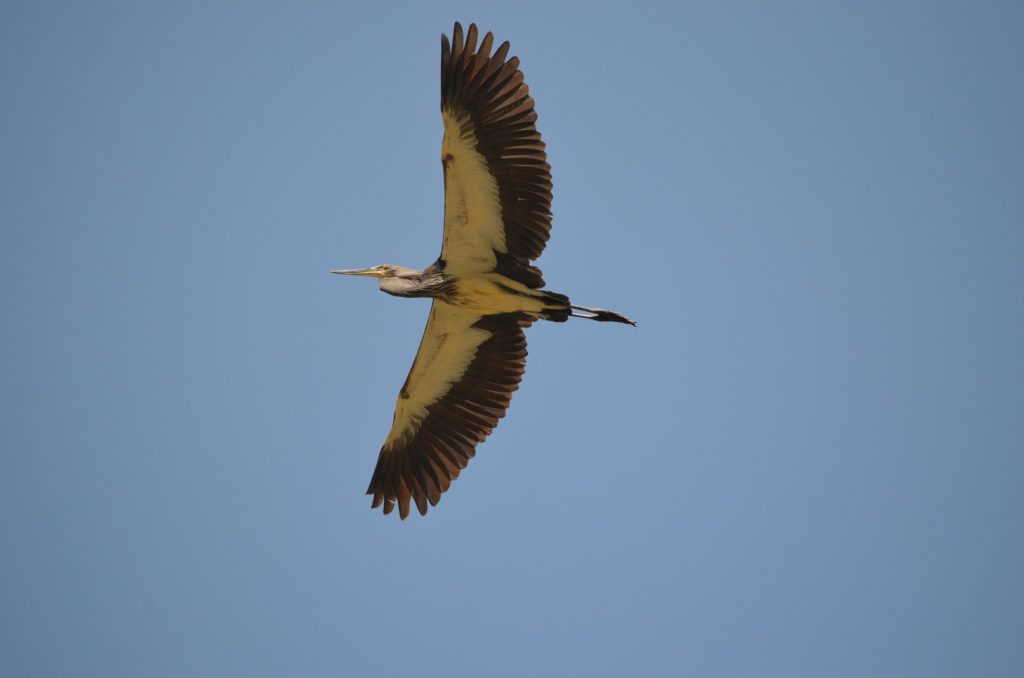Scientific name: Ardea insignis
Common name: Chubja Pho khab (Dzongkhag language)
Status: Critically Endangered, IUCN, Schedule-1
Population: Less than 60 individuals
Diet: Piscivore (Primarily dependent on fish)
Habitat: Fresh rivers, streams, lakes and wetlands in subtropical and temperate forest (Up to 2000 m of altitude)
Global Distribution range: Bhutan, India and Myanmar (Extinct from Nepal and Bangladesh)
Distribution range in Bhutan: Punatshangchhu,Mangdechhu and Lower Wangchu basins
Since 2003, RSPN has been working to conserve and protect the Critically Endangered White-bellied Heron(WBH), through scientific research, education outreach, and community-based conservation projects.
With only 60 known individuals left in the world as confirmed by the WBH conference held in Bhutan in 2015. Further a decline is projected in the near future as a result of the loss and degradation of lowland forest and wetlands, and through direct exploitation and disturbance.
The verge of WBH extinction compels the country’s stewards of this species to pursue measures to try and revitalize the wild population, in this case through advancements in conservation breeding and captive population management.
These birds are the indicator of the healthy Himalayan freshwater ecosystems.Their presence in the ecosystem indicates the health of the rivers, the environment, the fish population, water quality, health of freshwater biodiversity, level of disturbances, pollution, and above all the intactness of our nature. Their elusive and highly habitat specific habit in feeding, nesting, and food selection makes them great environmental sensors.
With a record of hosting 45% of the Global WBH population,Bhutan plays a pioneering role in protecting the critically endangered white-bellied heron. Although RSPN has initiated study on its ecology and breeding behavior, the rapid pace of development activities calls for immediate interventions that could provide quicker options for the survival of the bird. Captive breeding could be an immediate option to balance conservation and development by ensuring survival of the species and continuation of developmental activities – the “Middle Path” national development approach.
In Bhutan, WBH is distributed in temperate and mixed-broadleaf forests of three major river basins; Punatsangchhu, Mangdechhu and Kurigongri, at an altitudinal range of 100–1800 m.
In 2003, the RSPN initiated the WBH conservation projects, which resulted in discovery of the species in several other locations along the Punatsangchhu and Mangdechhu basins and recently in Kurigongri basin.
Today, it has been observed in more than 14 locales that are regularly occupied and used. As a result of the nationwide inventory conducted by RSPN and observations conducted by local birdwatchers, the distribution range in Bhutan expanded from previously recorded 600m–1200 m.a.s.l to above 1800 m.a.s.l in the inner Himalaya to below 150 m.a.s.l in the south. In recent years, the species has been sighted a few times from Kurichhu and Drangmechhu in eastern Bhutan.



Conservation initiatives RSPN in collaboration with partners has been monitoring WBH and several conservation initiatives have been taken to protect and revive the population size. The 2015 White-bellied Heron Conservation Strategy, collaboratively developed by experts and researchers from the species range countries, has streamlined species conservation priorities. Efforts are being made to streamline conservation of the birds across the range.
In Bhutan, RSPN has mapped the distribution across the country and identified essential feeding and nesting habitats. Consecutive population surveys have been conducted for nearly two decades, and population demographics, nest sites, and juvenile recruitment is being closely monitored. RSPN has also educated, inspired, and engaged local communities, students, researchers, institutions, and policymakers in the conservation of the species.
Currently research to understand the genetic diversity, ecology, biology, and threats to WBH are being undertaken throughout the habitat range. RSPN plans to tag juveniles with satellite transmitters to study the movement, local migration, and resource use by the species. WBH Conservation Center in Tsirang will hopefully secure an ex-situ gene-pool and seed population to supplement the wild population through captive breeding and release programs.
The WBH Conservation Center, the first of its kind in the world, exclusively for conservation and breeding of this species has been established in Bhutan. The purpose of the center is to secure an ex-situ gene pool; rear, raise and breed herons, and supplement the wild population by reintroducing them into safer habitats. It will also serve as the center for WBH research, a global information hub and coordinate WBH conservation in the region.
With WBH on the verge of extinction, compelling the country’s stewards of this species to pursue measures to try and revitalize the wild population,
in this case through advancements in conservation breeding and captive population management. While captive breeding is usually not recommended within standard guidelines for conservation,requiring vast amounts of time, capital, and expertise, it is seen as a viable last resort in the case of critically endangered species, and likely one of the only ways to feasibly envision saving this species from extinction.
A pilot captive rearing project was initiated in 2011, through a collaborative partnership between RSPN and the San Diego Zoo. The project gathered invaluable preliminary data and knowledge that will help to guide the institutionalization and husbandry operations of the captive rearing centre.
The success of this initial endeavor brings hope to the daunting prospect of upscaling conservation breeding strategies to ensure a future for the species
You can now be apart of our conservation initiatives and make a difference!
Copyright © 2024 RSPN All Rights Reserved